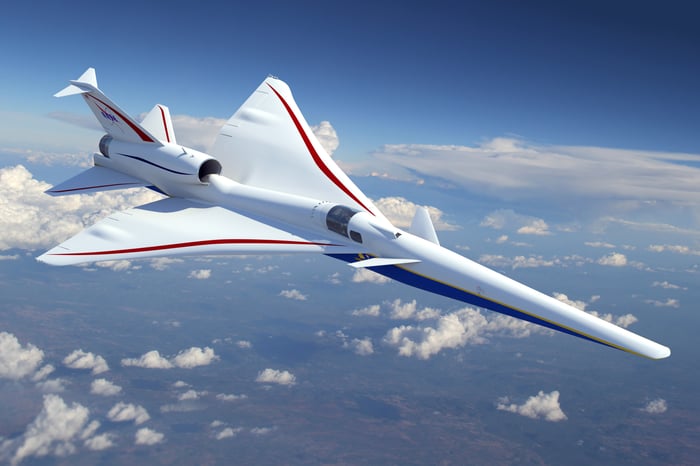Lockheed Martin (LMT -0.25%) has been awarded $247.5 million from NASA to develop a new generation of commercial aircraft able to travel at supersonic speeds without a full sonic boom, making it safer to nearby people and structures.
The money will be used to complete design and fabrication of an experimental aircraft capable of cruising at 55,000 feet at a speed of about 940 mph while reducing the sonic boom to what NASA calls "a gentle thump." The agency wants the plane to generate a sound of up to 75 perceived level decibel (PLdB), which it says is about as loud as a car door closing.
For Lockheed investors, this work is unlikely to really move the income statement in 2018. But the R&D work will trickle through the company's entire portfolio of jets, potentially making Lockheed Martin more competitive on future competitions. And if all goes well it could offer the company a pathway back into commercial aviation, opening up a new, large business segment to help better diversify the defense giant.

Artist's rendering of Lockheed Martin's supersonic commercial prototype. Image source: Lockheed Martin.
Delivery of the aircraft is expected in late 2021, with the agency planning a series of tests followed by flights over select U.S. cities to collect data about community responses to the noise. The data will then be provided to U.S. and international regulators for consideration when drafting new sound-based rules regarding supersonic flight over land.
NASA is hoping to use the demonstration to change regulations that currently ban supersonic flight over land regardless of noise level. The agency, along with commercial operators, would like those rules replaced with restrictions on the size of the boom permitted. NASA has been working on the concept with Lockheed and other contractors since 2010.
The work has the support of President Donald Trump. The White House in its fiscal 2019 budget request says funding for the project would "open a new market for U.S. companies to build faster commercial airliners, creating jobs, and cutting cross-country flight times in half."
Fast anywhere
Commercial travel hit supersonic speeds in 1976 when the Concorde took to the skies, but that aircraft, with a 105 PLdB boom, was limited to operating only over water due to concerns that the boom would break windows, scare livestock, and generally disrupt daily lives.
To make a new supersonic design cost-feasible, the airplane needs to be able to travel at top speeds over land and water, and that means reducing the boom. Lockheed Martin believes the narrow shape of the 94-foot demonstrator aircraft, with wings that span just 29.5 feet, will reduce the airframe drag and eliminate much of the sound that goes along with it.
Lockheed's design is also focused on affordability, borrowing components including the General Electric engine used on the Boeing Super Hornet and the landing gear from the F-16 to keep development costs low. Lockheed has previous experience developing supersonic aircraft for military applications, including the F-35 and F-22, and is collaborating with privately held Aerion to develop a prototype of a supersonic business jet.
Blazing new markets
It's been more than 30 years since the last Lockheed L-1011 TriStar rolled off the production line, effectively ending what is now Lockheed Martin's business as a manufacturer of commercial aircraft. The development of this new low-boom demonstrator suggests a potential path for the company back into the market.
Even if all goes according to plan and regulations are changed, Lockheed Martin will face significant competition in the supersonic market. Boeing and Northrop Grumman were also involved in the early stages of this NASA program, and have done extensive research that could be turned into a prototype if regulations were to change. Private companies are also working on concepts. Boom Technology announced last year it had potential orders for 76 airframes from five airlines ahead of a proposed 2023 launch date. Spike Aerospace hopes to test its concept this year.
It is way too early for supersonic commercial aircraft to be part of any sort of argument for buying shares of Lockheed Martin today, but given the long lead times common in defense contracting and Lockheed's growing reliance on the F-35, progress in new areas is a key reason current investors should hold on to Lockheed.
As technologies advance, the odds are improving that civilians will one day again be traveling faster than the speed of sound. Boeing estimates that $2.5 trillion will be spent by commercial airliners between 2017 and 2036 on wide-body jets typically used for long-range flying.
If supersonics could take a slice of that business, this experimentation would more than pay for itself.





